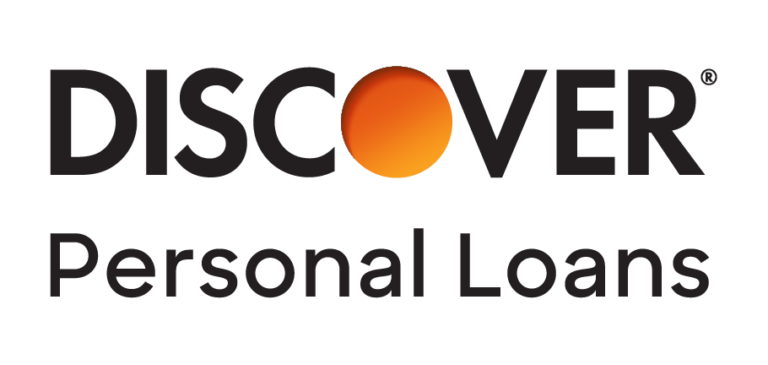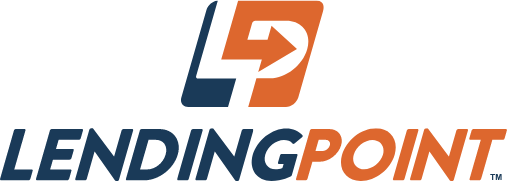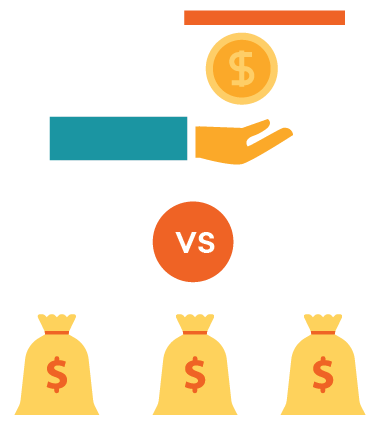Our goal is to give you the tools and confidence you need to improve your finances. Although we receive compensation from our partner lenders, whom we will always identify, all opinions are our own. Credible Operations, Inc. NMLS # 1681276, is referred to here as "Credible."
A personal loan or a personal line of credit could help you cover a major expense, such as home repairs or medical bills. But these financial products don’t work the same way. With a personal loan, you borrow a fixed amount of money over a set period, while a line of credit allows you to continuously borrow money after repayment, once you reset your credit limit.
Here’s how to choose between a personal loan vs. a personal line of credit:
- Personal loan vs. personal line of credit
- What is a personal loan?
- What is a personal line of credit?
- How to qualify for a personal line of credit
- When to choose a personal loan
- When to choose a personal line of credit
Personal loan vs. personal line of credit
While personal loans and personal lines of credit share some similarities, there are also major differences between the two — mainly in how you repay them.
- A personal loan is an installment loan. You receive a lump sum of money once you’re approved, and then you make fixed monthly payments with interest throughout the predetermined loan term.
- A personal line of credit is a type of revolving credit, like a credit card. You can access funds up to a set limit, but you don’t have to use them all right away. You make monthly payments with interest on only the amount you used, and you can continue to utilize your credit line during the “draw” period.
Here are some important points to keep in mind as you consider your options:
| Personal loan | Personal line of credit | |
| Type of credit | Installment | Revolving |
| Loan amounts | $600 to $100,000 (with Credible partner lenders) | $500 to $50,000 (on average) |
| How to qualify |
|
|
| Interest rate type | Fixed | Variable |
| Loan term | 1 to 7 years (depending on the lender) | Open ended |
| Fees | Depends on the lender, but might come with:
| Depends on the lender, but might come with:
|
| Funding | One-time lump sum | Ongoing access |
| Best for | One-time expenses, such as:
| Ongoing expenses, such as:
|
If you decide to take out a personal loan, be sure to consider as many lenders as possible so you can find the right loan for your situation. Credible makes this easy — you can compare your prequalified rates from multiple lenders in just two minutes. In addition, Credible partners with Tally, which offers a line of credit.
What is a personal loan?
A personal loan is a type of installment loan — meaning you’ll pay back the amount you borrow in fixed monthly installments over a period of time — that can be used for almost any personal expense.
Personal loans typically range from $600 to $100,000 (or more) with repayment terms from one to seven years, depending on the lender. You’ll receive your loan amount as a lump sum to use how you see fit. The time to fund a personal loan is usually about one week — though some lenders will fund loans as soon as the same or next business day after approval.
Here are some important points about personal loans to keep in mind:
- Interest rates: Most personal loans come with fixed interest rates, which means your rate and payment will stay the same throughout the life of your loan. With Credible partner lenders, personal loan rates start at 5.4%+ APR. Keep in mind that your credit will also affect the interest rate you get on a personal loan — in general, the higher your credit score, the lower your interest rate will be.
- Loan amounts: You can typically borrow $600 to $100,000 or more with a personal loan, depending on the lender. For example, you could borrow as little as $600 with PenFed while you might get $100,000 with SoFi. The amount you can get will also depend on your credit, debt-to-income (DTI) ratio, and your ability to repay the loan.
- Repayment terms: Personal loan terms usually range from one to seven years, depending on the lender. There are also some lenders that offer longer terms than this — for example, if you take out a LightStream loan and use the funds for home improvements, you could have up to 12 years to repay it.
- Funding: You’ll generally receive your funds from a personal loan within one week, depending on the lender. However, some lenders will fund loans as soon as the same or next business day after approval.
- Unsecured vs. secured: Some personal loans are unsecured, and some are secured. When you take out a secured loan, you back it with an asset, which is known as collateral. If you fail to repay your loan, the lender can seize the collateral. With unsecured loans, you don’t have to post collateral. While unsecured loans tend to have a higher interest rate, they’re a lot less risky for you as the borrower. You can easily compare rates on unsecured personal loans with Credible.
Learn More: Types of Personal Loans
How to qualify for a personal loan
While eligibility criteria can vary by lender, there are common personal loan qualifying requirements, including:
- Good credit: You’ll typically need good to excellent credit to qualify for a personal loan — a good credit score is usually considered to be 700 or higher. There are also several lenders that offer personal loans for bad credit, but these loans tend to come with higher interest rates compared to good credit loans.
- Verifiable income: Some lenders have a minimum income requirement while others don’t — but in either case, you’ll likely need to provide proof of income so the lender knows you’ll be able to afford repayment.
- Debt-to-income (DTI) ratio: This is the amount you owe in monthly debt payments compared to your income. Lenders typically like to see a DTI ratio no higher than 40% — though some lenders might require lower ratios than this.
Even if you don’t need a cosigner to qualify, having one could get you a better interest rate than you’d get on your own.
Check Out: Low-Income Loans: Personal Loans for a Tight Budget
Pros of a personal loan
- Fixed interest rates: Personal loan interest rates are usually fixed. This means your payment will stay the same throughout the life of your loan. Additionally, personal loan rates tend to be lower compared to rates on personal lines of credit or credit cards.
- Long terms: Depending on the lender, you could have up to seven years (or more, in some cases) to repay your loan.
- Variety of uses: You can use a personal loan to cover almost any personal expense.
Cons of a personal loan
- Fewer options for poor or fair credit: Most personal loan lenders require borrowers to have good to excellent credit. If you have poor or fair credit, you might have a harder time qualifying.
- Could come with fees: Some lenders charge fees on personal loans, such as origination or late fees. These could drive up the overall cost of your loan.
- Lump-sum payment: If you end up needing more money than you initially borrowed, you’ll have to take out another loan.
If you choose to get a personal loan, remember to consider as many lenders as you can to find the right loan for your needs. This is easy with Credible — you can compare prequalified rates from our partner lenders in the table below in just two minutes.
| Lender | Fixed rates | Loan amounts | Min. credit score | Loan terms (years) |
|---|---|---|---|---|
 | 9.95% - 35.99% APR | $2,000 to $35,000** | 550 | 2, 3, 4, 5* |
|
||||
 | 8.24% - 18.99% APR | $10,000 to $50,000 | 730 | 3, 4, 5, 6 |
|
||||
 | 6.99% - 35.99% APR | $2,000 to $50,000 | 600 | 2, 3, 4, 5 |
|
||||
 | 7.99% - 24.99% APR | $2,500 to $40,000 | 660 | 3, 4, 5, 6, 7 |
|
||||
 | 7.95% - 29.99% APR | $3,000 to $40,000 | 640 | 2, 3, 4, 5 |
|
||||
 | 7.04% - 35.99% APR | $1,000 to $40,000 | 660 | 3, 5 |
|
||||
 | 7.99% - 35.99% APR | $2,000 to $36,500 | 660 | 2, 3, 4, 5, 6 |
|
||||
 | 6.49% - 25.29% APR with autopay | $5,000 to $100,000 | 700 | 2, 3, 4, 5, 6, 7 (up to 12 years for home improvement loans) |
|
||||
 | 18.0% - 35.99% APR | $1,500 to $20,000 | 540 | 2, 3, 4, 5 |
|
||||
 | 8.49% - 17.99% APR | $600 to $50,000 (depending on loan term) | 760 | 1, 2, 3, 4, 5 |
|
||||
| 8.74% - 35.49% APR10 | $5,000 to $100,000 | Does not disclose | 2, 3, 4, 5, 6, 7 | |
|
||||
 | 11.69% - 35.99% APR7 | $1,000 to $50,000 | 560 | 3, 5, or 7 years 8 |
|
||||
 | 7.74% - 35.99% APR | $1,000 to $50,000 | 600 | 2, 3, 4, 5, 6, 7 |
|
||||
 | 6.6% - 35.99% APR4 | $1,000 to $50,0005 | 620 | 3 or 5 years4 |
|
||||
What is a personal line of credit?
Unlike a personal loan, a personal line of credit is a type of revolving credit line that you can repeatedly draw on and pay off — similar to a credit card. This could be helpful if you are not sure how much you have to borrow or have ongoing expenses to cover. Additionally, most personal lines of credit are unsecured, but you may also see secured personal lines of credit.
Be cautious if you choose a secured personal line of credit — if you fail to make payments, the lender can take possession of your collateral. Credible’s partner lender Tally offers unsecured lines of credit.
Personal line of credit limits generally range from $500 to $50,000 on average, though the actual limit you’ll get will depend on the lender and your credit. Keep in mind that personal lines of credit typically come with variable interest rates, which means your rate could fluctuate over time depending on market conditions.
Here are several important points to keep in mind when considering a personal line of credit:
- Interest rates: Personal lines of credit usually come with variable interest rates, which means your rate could change in the future. These rates are usually lower compared to credit card rates but are generally higher than personal loan rates.
- Loan amounts: On average, personal line of credit limits can range from $500 to $50,000 or more, depending on the lender. The credit line you get will also depend on your credit — generally, borrowers with better credit can qualify for higher credit limits.
- Repayment terms: Because a line of credit is a revolving type of credit, you won’t have a set repayment term. Instead, you can generally repeatedly draw on your credit line as long as you continue to pay it off. However, keep in mind that some lenders set a limit on the amount of time you can access your line of credit funds — this is known as a draw period and usually lasts for several years.
- Funding: You’ll typically get access to your line of credit as soon as you’re approved and the loan is processed. In some cases, approval could take only a few minutes, but it could take longer if your application requires further information.
Learn More: 4 Long-Term Loans for All Credit Types
How to qualify for a personal line of credit
Personal lines of credit generally have similar eligibility requirements as personal loans, including:
- Good credit: Like a personal loan, you’ll typically need good to excellent credit to qualify for a line of credit. Your credit will also be a determining factor in the credit limit you get — in general, the better your credit, the higher the credit limit you might be able to get.
- Verifiable income: You’ll likely need to provide proof of income. This way, the lender can make sure you’ll be able to afford repayment.
- DTI ratio: Lenders often prefer to see DTI ratios of 36% or lower — though some lenders might accept higher ratios than this.
Check Out: Personal Loan vs. Credit Card
Pros of a personal line of credit
- Revolving credit: With a personal line of credit, you’ll be able to repeatedly draw on and pay off your credit line. This could make a line of credit ideal if you need ongoing access to cash, such as with long-term projects.
- Lower interest rates: Personal lines of credit often come with lower interest rates compared to credit cards. Additionally, you’ll only pay interest on what you actually borrow from your credit line.
- Variety of uses: Like with a personal loan, you can generally use your line of credit to pay for any personal expense.
Cons of a personal line of credit
- Variable interest rates: Personal lines of credit usually come with variable rates. This means your rate could fluctuate over time.
- Could come with fees: A personal line of credit might come with various fees, such as annual, overdraft, or late fees.
- Might lead to more debt: Like a credit card, a line of credit provides ongoing access to a credit limit. For some borrowers, it could be tempting to rack up a balance — leading to a higher debt load.
Learn More: How Personal Loans Impact Your Credit Score
When to choose a personal loan
A personal loan could be a good option if you have a one-time expense to cover and know exactly how much you need to borrow. For example, you could use a personal loan to pay for a wedding or debt consolidation. Or you might use a home improvement personal loan to cover home repairs.
If you decide that a personal loan is a more optimal fit for you, remember to shop around and compare as many lenders as possible to find the right loan for you. This is easy with Credible: You can compare your prequalified rates from multiple lenders in two minutes — without affecting your credit.
When to choose a personal line of credit
A personal line of credit might be a better choice if you need ongoing access to cash or aren’t sure exactly how much you need to borrow. For example, if you’re updating your home, your costs might change over time. You could use a personal line of credit to purchase new furnishings, update the bathroom, and hire painters as issues pop up.
Keep Reading: Debt Consolidation vs. Personal Loan: What Is the Difference?
Emily Guy Birken has contributed to the reporting of this article.
Prequalified rates disclosure: Prequalified rates are based on the information you provide and a soft credit inquiry. Receiving prequalified rates does not guarantee that the Lender will extend you an offer of credit. You are not yet approved for a loan or a specific rate. All credit decisions, including loan approval, if any, are determined by Lenders, in their sole discretion. Rates and terms are subject to change without notice. Rates from Lenders may differ from prequalified rates due to factors which may include, but are not limited to: (i) changes in your personal credit circumstances; (ii) additional information in your hard credit pull and/or additional information you provide (or are unable to provide) to the Lender during the underwriting process; and/or (iii) changes in APRs (e.g., an increase in the rate index between the time of prequalification and the time of application or loan closing. (Or, if the loan option is a variable rate loan, then the interest rate index used to set the APR is subject to increases or decreases at any time). Lenders reserve the right to change or withdraw the prequalified rates at any time.






